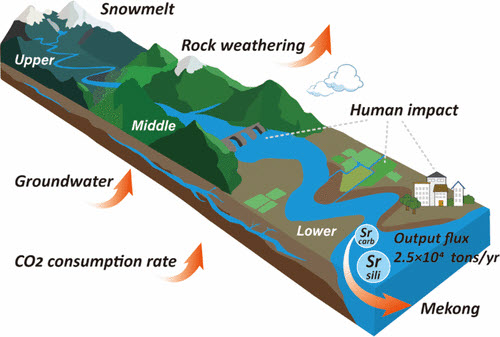Shitong Zhang:Bayesian Model Revealing Segment-Scale Elemental Flux, Doubled CO2 Consumption, and Potential Anthropogenic Impact in the Upper Mekong Basin: Constraints from Strontium Isotopes【EST,2025】
May 28, 2025
Views:3
Lancang River (LCR), the upper region of the large transboundary Mekong River, provides a critical understanding of terrestrial weathering status and CO2 consumption. Riverine Sr isotopes play a crucial role in identifying the link between continental weathering and the nearby ocean. This study reported spatial variations of Sr data from LCR during the flood season, and Sr isotopes were coupled with hydrochemical data based on a Bayesian model to assess solute sources. Results showed that carbonate weathering was the predominant contributor to riverine dissolved Sr (contribution ratio ~35%). Besides, halite dissolution, silicate weathering, and groundwater contributed 28, 16, and 12% of dissolved Sr, respectively. The chemical weathering rate of LCR was relatively high, and the level of CO2 consumption doubled within a decade, indicating potential regional climate change. Flux estimations revealed that 42.9 tons of 87Sr were introduced to the Mekong River annually, eventually reaching the Pacific Ocean. Silicate-derived Sr accounted for 38% of this flux, exerting a significant influence on seawater Sr-isotopic composition. Dam construction and a warming climate with accelerated snow melting (headwater area) and increased precipitation may enhance the suitability of chemical weathering. A more systematic study on the controlling factors of weathering is needed to provide better insight into basin management in the Lancang-Mekong region.

Article link: https://doi.org/10.1021/acs.est.4c12202





 Address
Address
 E-Mail
E-Mail
 Telephone
Telephone